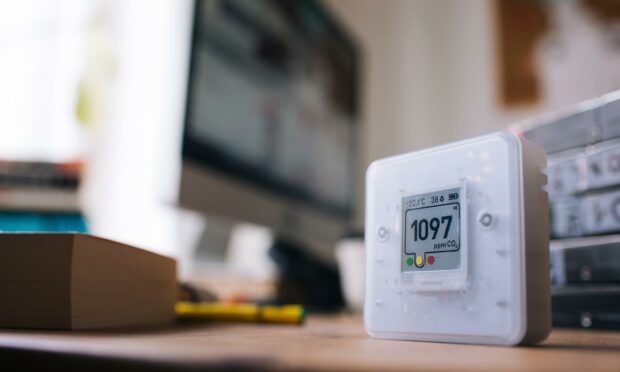Teachers are having to share carbon dioxide monitors which can indicate increased transmission risk of Covid-19 in their classrooms.
CO2 monitors have been provided to schools across Tayside, Fife and the rest of Scotland to help show when more ventilation is needed to prevent airborne transmission.
As winter approaches widespread access to the devices could allow teachers – who are mostly reliant on opening doors and windows to improve ventilation – to see when less as well as more fresh air is needed.
Despite £10 million being pledged by the Scottish Government to ensure every school has access to the devices – which detect a build-up of exhaled CO2 – many teachers are having to share the devices between several classrooms.
How many carbon dioxide monitors do schools have?
By the end of last term Fife Council‘s 179 schools and free-standing nurseries had been provided with 1,290 carbon dioxide monitors, outside those already fitted with permanently-installed devices.
There were 1,523 CO2 monitors in Perth and Kinross Council‘s 81 schools and nurseries and 1,117 in Dundee City Council‘s 55 schools and nurseries.
In Angus Council‘s 63 schools and nurseries, there were already 1,581 and the authority said it is procuring more for every classroom.
Keeping windows open
Across Scotland, some teachers have reported on social media that they are yet to see a CO2 monitor or have had access only for a few hours or days.
A local teaching union spokesman called for the devices to be provided for every classroom so teachers are alerted as soon as more fresh air is needed – and importantly in colder weather when less is needed.
David Farmer, of EIS Fife, said: “While we appreciate the money from the Scottish Government, it’s not enough.
“It’s not providing a monitor for every classroom in every school.”
Kids were having to keep their jackets on, their hats on; it was cold.”
David Farmer, EIS Fife
Last year, he said, teachers had to err on the side of caution and keep windows open but this year monitors could let them see when it is safe to keep rooms warmer.
He said: “Kids were having to keep their jackets on, their hats on; it was cold.”
Teachers, he said, recognised the value of having monitors and maintaining good ventilation.
“It’s about striking a balance between safety and comfort and not having to be sitting in our classrooms with our jackets and hats on to keep warm.”
Announcing funding in August to ensure monitors for every school and childcare setting, First Minister Nicola Sturgeon said ventilation was “vital” to ensure they were as safe as possible.
What has been done to help teachers?
Education Secretary Shirley-Anne Somerville said: “We are providing local authorities with an additional £10 million to ensure that schools and childcare settings have access to CO2 monitoring whether fixed or mobile, to help improve ventilation.
“This is on top of £90 million Covid logistics funding already provided to councils.
“Our updated guidance, published in August, asked councils to complete assessments of their schools and early learning and childcare settings by October half-term wherever possible, subject to sufficient supplies of CO2 monitors being available for purchase.
“We also made clear that these assessments should be used to inform actions to improve ventilation where issues are identified.
“Many local authorities have already reported progress in addressing ventilation issues in the school estate using our guidance, much of which has been in place since last year.”
